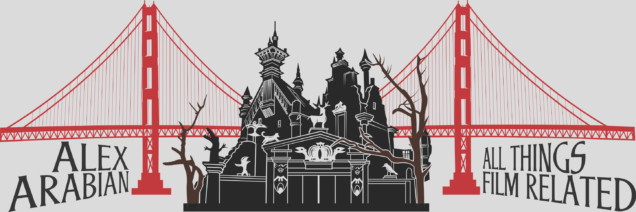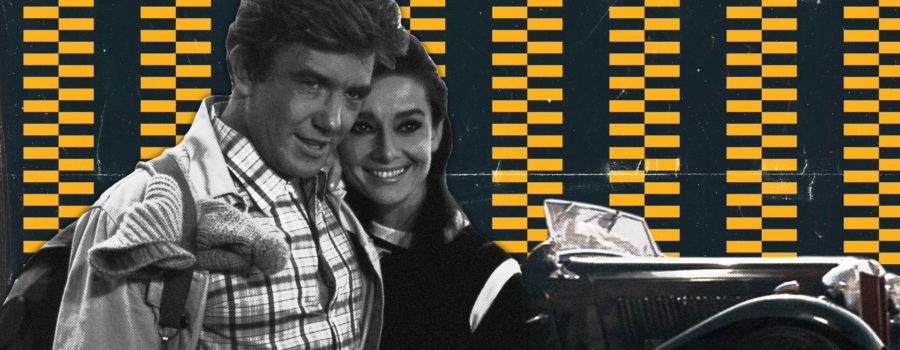[Published at Living Life Fearless] Two for the Road is the one of the most underrated masterpieces in the annals of film’s archives. Decades ahead of its time, it set the standard for today’s experimental romantic comedy 53 years ago.
Stanley Donen’s (Singin’ in the Rain) romantic drama is more akin to a series of non-linear vignettes of a couple falling in and out of love than to the traditionally-structured, three-act film. Frederic Raphael’s (Eyes Wide Shut) non-linear script sprawling a decade, which was nominated for an Oscar, played with cinematic time before Richard Linklater’s Before Trilogy did. The film’s esoteric discussions and insouciant approach to gender roles and aging preempted those of Linklater and the likes of Michel Gondry’s Eternal Sunshine of the Spotless Mind and Sofia Coppola’s Lost in Translation. Further, it remains Audrey Hepburn’s finest performance as well one of Albert Finney’s. The mold that keeps this script together is Madelèine Gug and Richard Marden’s sui generis editing, with the two seamlessly slicing celluloid in the cutting room as if they had it meticulously mapped out beforehand in their heads like Russell Crowe in A Beautiful Mind.
Decades ahead of its time, it set the standard for today’s experimental romantic comedy
Not only is it a prerequisite to many romantic comedies that would precede it, most of which paled in comparison to this film, but it was also an early influence on other narratively-rule-breaking, delightfully desultory delineations of mercurial men and women of the Jim Jarmusch and Charlie Kaufman era. Let us analyze Two for the Road’s vast influence on modern experimental films that dared to remove the lens and ask the viewer to remove the proverbial They Live-esque glasses they’ve fashioned for themselves in order to understand the world in a rigid way as reinforced by a cultural hegemony that suppresses the act of breaking from structure, traditional values, and the current norm – and that especially extends to creative mediums.
A Series of Vignettes
Two for the Road dissolves the glasses from Zizek’s They Live analogy and dissects the modern American film through one couple’s romantic journey. It appears to jump, non-linearly, from moment to moment in a relatively blasé fashion, at first, while simultaneously allowing room for narrative empathy. Upon closer viewing, however, each event is purposefully placed. What are our lives, if not a series of events that we mostly consume on figurative autopilot? In taking this narrative approach, it reminds the viewer not to take the simple things in their own lives for granted; it is an entirely refreshing, non-didactic approach. One that Jarmusch would take in Coffee and Cigarettes and Night on Earth. One that Linklater would take in Slacker, Before Sunrise, Before Sunset, Before Midnight, and Boyhood. One that Spike Jonze and Kaufman would take in Being John Malcovich and Adaptation. One that Gondry and Kaufman would take in Eternal Sunshine of the Spotless Mind. One that Coppola would take in all of her films, but most notably with the bleak, mundane romance of Lost in Translation, which in many ways, reflected that of Two for the Road’s central relationship. One that director Marc Webb and screenwriters Scott Neustadter and Michael H. Weber would take in 500 Days of Summer.See also
One can argue that Two for the Road, along with the Italian Neorealism movement, inspired the films of the “mumblecore” movement as well. Those films were particularly narratively aimless but conceptually and emotionally pointed. This film has narrative intent, however. Even though it may seem erratic, each frame is meticulously constructed, each scene a piece of a larger, perplexing puzzle.
Prerequisite Performances
Third time’s a charm, as the cliché saying goes. Two for the Road marks Hepburn and Donen’s third collaboration together after Funny Face and Charade, and not only their best film, but also Hepburn’s career-best performance. That is undoubtedly an unpopular opinion, considering the legendary actor’s impressive breadth of work. However, along with Finney, she creates magic through the use of unfettered realism. And she was nominated for a Golden Globe for Best Actress to boot. Although Two for the Road isn’t improvised, it seems as though the two leads are making up their dialogue as they go. As if their fights, their tender, mutual adoration and adulation haven’t been predetermined or rehearsed. This realism is what filmmakers like Jarmusch, Linklater, Coppola, and the filmmakers of mumblecore strived to encapsulate. Performances that paralleled those of the Italian Neorealist films, when many filmmakers used non-actors to reflect the actualities of their harsh surroundings.
Gug & Marden’s Masterful Maze
This film wouldn’t work without the right editing, as the plot is closer to a seven-act structure than the commonly used three-act structure in Hollywood. That isn’t to say there isn’t a beginning, a middle, and an end, but it defines those chapters by its own terms. Piecing together a plot like this takes a tedious eye. Specifically, as each chapter takes place in a different time period, cars and costumes are two visual markers that begin and develop a setting. This was long before Martin Scorsese redefined the period piece by shattering the standards for attention-to-detail in The Aviator, for which he crafted each year in his biopic to appear exactly as the color movie from that time period would look, whether it be Cinecolor, two-strip, or three-strip Technicolor, primarily through sophisticated post-production techniques, and spent $2 million on costumes.
This was long before Martin Scorsese redefined the period piece by shattering the standards for attention-to-detail in The Aviator
When the editing is dissected and rearranged in Two for the Road (each chapter’s narrative is revisited intermittently throughout the film), it tells seven chapters of the protagonist’s story. A renowned architect, Mark (Finney), with a pricey sports coat, and his wife Joanna (Hepburn), with a Louis Vuitton sunglasses and bag, drive their white 1965 Mercedes 230 SL (W113) along a windy, picturesque road in the French Riviera, to Saint-Tropez in order to celebrate a lucrative project-closing with an old client, Maurice (Claude Dauphin), introducing their film’s villain, in a sense.
Ironically, pass a wedding in the first shot of a movie, the young bride and groom, full of hope and passion, symbolically riding away in the opposite direction in their Vanden Plas Princess 4-Litre Limousine. At the end of their marriage, bickering and tired of each other’s presence, they look back in retrospect at other times they’ve driven on the same windy, picturesque road, and the periods associated with those chapters in their relationship. A commonality throughout their troubled evolution is Maurice’s meddling presence.
The Honeymoon Period
Mark and Joanna first meet on in 1954, when Mark was traveling solo and Joanna belonged to a girls’ choir. At first at a ferry crossing, then again by coincidence when Joanna’s VW Micro Bus choir vehicle is driven off the road by a Peugeot 203, promoting Mark to get off of the back of the chauffeur-driven MAP DR 3 tractor on which he was traveling and help the girls’ choir back on the road. When coincidence turns to fate, every girl in the choir comes down with chickenpox except Joanna, causing Joanna and Mark to hitchhike together on a whim on a Simca Ariane, a Peugeot 203 Camionnette Bâchée (C8), a Berliet GLA, a Citroën 2CV AZLP, and a Alfa Romeo Giulia 1600 Sprint [101.12]. During this journey, like Jesse in Before Sunrise, Mark shares his borderline chauvinistic views on women, while also appearing to display genuine empathy and a slight open-minded air about him. The instant mutual attraction, the “horror” and “heroism,” the chance encounters, the spontaneity, are all ingredients that ignite their relationship, marking a passionate honeymoon phase, if you will. A different white Mercedes 230 SL (W113) passes them by, segmenting them into the present day in their own Speedster, with Joanna boasting an expensive black PVC trouser suit designed by the “enfant terrible,” or unruly child of the 1960s French fashion scene Paco Rabanne, upon when they pass hitchhikers reminiscent of their naive, younger selves.
In our next chapter, now married, Mark and Joanna are pitted against Mark’s ex-girlfriend Cathy (Eleanor Bron), her husband (William Daniels) and daughter Ruthie (Gabrielle Middleton), on vacation in the French Riviera while driving in their Ford Country Squire (79E), a vehicle well-equipped for carrying heavy luggage. Cathy’s petty husband and their poorly-raised and troublesome Ruthie put a damper on Mark and Joanna’s vacation, with the nail in the coffin being the bad seed revealing the unflattering depictions that Cathy and her husband truly paint Joanna as. Again, in this chapter, Mark and Joanna end up traveling alone. Mark stands up for Joanna, severing friendly ties with his ex. Jealousy and family dysfunction doesn’t yet put a roadblock in their flourishing relationship. After Ruthie’s encounter, the couple reassesses their vow to never have children, foreshadowing their unexpected next chapter.

Back Down to Earth
The next phase of a relationship is usually followed by a reality check. Either tension, arguing, unexpected life events, or all of the above. In the third chapter, the couple is seen driving an MG TD just as it begins having problems with its exhaust, eventually catching on fire. This creates tension, as Mark makes Joanna take the brunt of the work. Mark never seems entirely content with his life. It’s him, but he lashes out on other people. During a chance encounter disposing of the MG TD, they meet Maurice and his wife Françoise (Nadia Gray) for the first time, driving in his Bentley S1 (the same model is used to cut off Cathy, her husband, Ruthie, Mark, and Joanna in the prior chapter, structurally following this scene, as a visual transition, beginning the trip’s downfall) while Joanna announces that she is pregnant. Maurice helps make Mark’s career. With that success, comes infidelity, materialism, and loss of values. Again, anything related to or close to Maurice withers. The destruction of the MG TD can be seen as a foreshadowing and symbol of their dysfunctional relationship, with it inevitability catching fire from the overwhelming sparks that ignited it. However, they are committed to each other now, with a child on the way, for better or for worse, as they say. They must attempt to work together to put out that fire.
The fourth chapter takes us to the same road, only this time the couple is with their young daughter Caroline (Kathy Chelimsky) in a red Triumph Herald Convertible (this scene structurally follows the next chapter to establish a sharp tonal contrast with the use of this convertible as another visual transition). Caroline appears to be keeping the couple together as their mutual passion begins to fade.
The Disappointment Phase
The fifth chapter departs from form, as we see Mark not only traveling without Joanna in the Triumph Herald Convertible (seen passing the couple by, as they leave Cathy, her husband, and Ruthie to enjoy the rest of the vacation with each other, which, structurally occurs before this scene as yet another visual segue into this different timeline) but also cheating on her with another woman driving a sleek Renault Floride Cabriolet.
Meanwhile, in an alternate chapter, Joanna has an affair with Françoise’s brother David (Georges Descrières) as she’s whisked away in his private Reg. F-CBAF Caudron C. 800 Epervier plane. Whereas Mark’s is simply a fling, Joanna’s has the potential for something deeper. However, a silent but content married couple on a dinner date reminds her of Mark on a previous dinner date and her longing for the little passion that is still there, so the couple reconciles in the hope of salvaging said passion.
The End of the Road or a New Chapter?
Mark and Joanna never reach the stability and commitment stages in their relationship through Two for the Road’s use of flashbacks. However, in the final chapter, they promise these things to each other in the future, confronting the perceived inadequacies that have weighed down their potential as a couple. Whereas in the beginning chapter, they are traveling to celebrate a deal with Maurice, in this bookend, after reflecting on their marriage on the same trip, with a less-than-invigorating party at Maurice’s solidifying their change of heart, they aim to end their toxic relationship with the mogul, embarking upon a new journey to Rome in search of a new Maurice. The crossing of the border from France into Italy in the same Mercedes that opened the film not only symbolizes a new, unforeseen chapter as they head towards stability and commitment, determined to create a better life for themselves and Caroline, but it also shows that a seasoned couple can evolve and break destructive habits.
Two for the Road’s Lasting Influence
The opening credits allude to the various cars used in Two for the Road through slick animation, primarily highlighting the couple’s formative years in their Mercedes Speedster. The way the couple romanticizes their time in each car, describing its unique intricacies and flaws, this film could arguably be considered as much of a car movie as it is a romance or road trip one. In fact, the Mercedes Speedster belonged to Donen at the time of production. Masterfully, the penultimate sequence displays all the cars used throughout the film fluidly together. And although Two for the Road is deemed, in part, a road trip film, it’s actually several road films blended into 111 minutes, with each one telling a different story. Each one cuts back and forth to every moment of these places in time methodically in order to paint a detailed portrait of a rocky relationship. And in spending so much time analyzing the mechanics of a marriage on the edge from a calculated distance, Donen, Raphael, Gug, and Marden allow the viewer to feel the full range of emotion they want them to feel with ease. It is a marriage that is one-sided. Dominated by a bull-headed Mark who takes Joanna’s unconditional love and loyalty for granted. Like the seeming male protagonist in 500 Days of Summer, Mark is eventually revealed as the true cause of the couple’s internal issues.
This film could arguably be considered as much of a car movie as it is a romance or road trip one
If the viewer blinks, they may miss something vital in Two for the Road. The cuts get faster as the film progresses; if it had a third act, it would be consisted of a seemingly erratic series of unrelated scenes. It’s a film that requires multiple viewings. Even then, there’s always something to absorb upon yet another viewing. The fragmented scenes represent the shattered relationship at the center of the film. Slowly, by the end, Mark and Joanna attempt to pick up these scenes, these pieces, together, just as the audience must in order to understand their complex relationship. The film’s composer, Henry Mancini, who was nominated for a Golden Globe for his score, and who also composed “Moon River” for Hepburn in the iconic Breakfast at Tiffany’s, considers his “Two for the Road” theme the superior work of his career. As aforementioned, Hepburn was also nominated for a Golden Globe.
Walking and talking. Driving and talking. The former and latter and arguing. Philosophical musings. Narrative detours such as playfully guessing other couples’ conversations from afar or swimming in the Mediterranean. Periods of silence. Growing with two lovers over a lengthy period of time. A non-linear narrative. Innovative editing. All of these variables set the stage for the next generation of like-minded films that would emerge decades later. Only the Before Trilogy would rival its perfect analysis of an imperfect relationship.





Leave a Reply
Your email is safe with us.